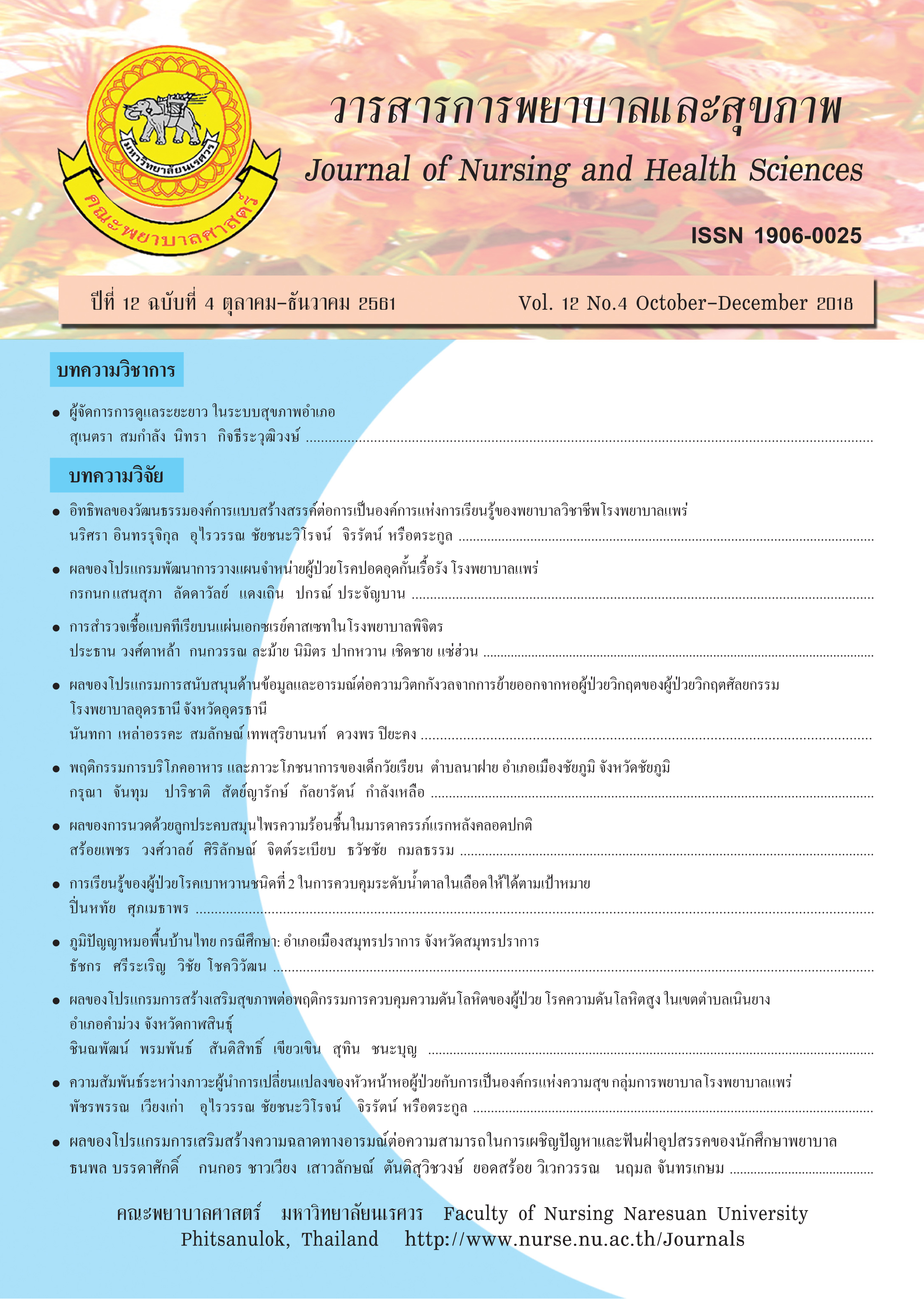ผลของโปรแกรมการสนับสนุนด้านข้อมูลและอารมณ์ต่อความวิตกกังวลจากการย้ายออกจาก หอผู้ป่วยวิกฤตของผู้ป่วยวิกฤตศัลยกรรม โรงพยาบาลอุดรธานี จังหวัดอุดรธานี
Main Article Content
บทคัดย่อ
การวิจัยครั้งนี้เป็นการวิจัยกึ่งทดลอง ชนิดสองกลุ่ม มีวัตถุประสงค์เพื่อศึกษาผลของโปรแกรมการ สนับสนุนด้านข้อมูลและอารมณ์เพื่อลดความวิตกกังวลจากการย้ายออกจากหอผู้ป่วยวิกฤตของผู้ป่วยวิกฤต ศัลยกรรม กลุ่มตัวอย่างเป็นผู้ป่วยวิกฤตศัลยกรรมที่มารับการรักษาที่หอผู้ป่วยวิกฤตศัลยกรรม โรงพยาบาล อุดรธานี จำนวน 32 คน โดยวิธีคัดเลือกกลุ่มตัวอย่างแบบเฉพาะเจาะจง กลุ่มควบคุมได้รับการพยาบาล ตามปกติ กลุ่มทดลองได้รับโปรแกรมการสนับสนุนด้านข้อมูลและอารมณ์ เครื่องมือที่ใช้ในการวิจัย คือ โปรแกรมการสนับสนุนด้านข้อมูลและอารมณ์สร้างขึ้นจากแนวคิดความวิตกกังวลจากการย้ายออกจาก หอผู้ป่วยวิกฤตของลิท (Leith, 1998) เครื่องมือที่ใช้ในการเก็บรวบรวมข้อมูล ได้แก่ แบบสอบถามข้อมูล ทั่วไป และแบบสอบถามความวิตกกังวลก่อน และหลังการย้ายออกจากหอผู้ป่วยวิกฤต มีค่าสัมประสิทธิ์แอลฟา ของครอนบาค (Cronbach's Alpha Coefficient) เท่ากับ 0.89 และ0.94 ตามลำดับ วิเคราะห์ข้อมูลทั่วไปของ ผู้ป่วยโดยใช้ ความถี่ ร้อยละ ค่าเฉลี่ย ส่วนเบี่ยงเบนมาตรฐานและการทดสอบไคสแควร์ เปรียบเทียบ ความวิตกกังวลจากการย้ายออกจากหอผู้ป่วยวิกฤตของผู้ป่วยวิกฤตศัลยกรรมก่อนและหลังได้รับโปรแกรม การสนับสนุนด้านข้อมูลและอารมณ์ด้วยสถิติทีคู่ (Paired t-test) และเปรียบเทียบความวิตกกังวลจากการ ย้ายออกจากหอผู้ป่วยวิกฤตของผู้ป่วยวิกฤตศัลยกรรมระหว่างกลุ่มควบคุมที่ได้รับการพยาบาลตามปกติ และกลุ่มทดลองที่ได้รับโปรแกรมการสนับสนุนด้านข้อมูลและอารมณ์ด้วยสถิติทีอิสระ (Independent t-test)ผลการวิจัยพบว่า ผู้ป่วยวิกฤตศัลยกรรมที่ย้ายออกจากหอผู้ป่วยวิกฤตศัลยกรรมไปหอผู้ป่วยทั่วไปที่ ได้รับโปรแกรมการสนับสนุนด้านข้อมูลและอารมณ์มีคะแนนเฉลี่ยความวิตกกังวลหลังย้ายออกต่ำกว่าก่อน ได้รับโปรแกรมอย่างมีนัยสำคัญทางสถิติ (p < .05) และ มีคะแนนเฉลี่ยความวิตกกังวลหลังย้ายออกจาก หอผู้ป่วยวิกฤตต่ำกว่ากลุ่มที่ได้รับการพยาบาลตามปกติอย่างมีนัยสำคัญทางสถิติ (p < .05) จากผลการวิจัย แสดงให้เห็นว่าโปรแกรมการสนับสนุนด้านข้อมูลและอารมณ์ สามารถลดความวิตกกังวลจากการย้ายออกจาก หอผู้ป่วยวิกฤต นำไปใช้เพื่อเป็นแนวทางสำหรับพยาบาลในหอผู้ป่วยวิกฤตศัลยกรรมในการดูแลผู้ป่วยวิกฤต ศัลยกรรมที่ย้ายออก ไปหอผู้ป่วยทั่วไปได้
Article Details
เอกสารอ้างอิง
ข้อมูลและอารมณ์ต่อความวิตกกังวลของญาติ
ผู้ป่วยที่ได้รับบาดเจ็บจากอุบัติเหตุ. วิทยานิพนธ์
พย.ม., มหาวิทยาลัยเชียงใหม่: เชียงใหม่.
เกษร ปัญญาใส. (2553). ผลของการสนับสนุนด้าน
ข้อมูลและอารมณ์ต่อความวิตกกังวลและ
ความพึงพอใจของสมาชิกในครอบครัวผู้ป่วย
ในหอผู้ป่วยหนักทั่วไป โรงพยาบาลลำปาง.
วิทยานิพนธ์ พย.ม., จุฬาลงกรณ์มหาวิทยาลัย,
กรุงเทพฯ.
ปราณี ทองใส, น้ำทิพย์ กุณา, จารุวรรณ พงษ์ปราโมทย์,
และพันธุศักดิ์ ลักษณบุญส่ง. (2554). ผลของ
โปรแกรมเตรียมความพร้อมในการย้ายออกจาก
ไอ ซี ยู ในผู้ป่วยผ่าตัดทำทางเบี่ยงหลอดเลือด
หัวใจและผ่าตัดเปลี่ยน/ซ่อมลิ้นหัวใจต่อความ
วิตกกังวลจากการย้ายและความพึงพอใจ.
วารสารพยาบาลศาสตร์, 29(4), 28-36.
แผ จันทร์สุข. (2556). การดูแลบุคคลที่มีความวิตกกังวล
(Caring of anxiety) ใน ฉวีวรรณ สัตยธรรม,
แผ จันทร์สุข, และ ศุกร์ใจ เจริญสุข (บรรณาธิการ),
การพยาบาลจิตเวชและสุขภาพจิต (ฉบับปรับปรุง).
นนทบุรี: ธนาเพรส.
รุ่งนภา ธนูชาญ, อภิญญา วงศ์พิริยโยธา, และสุพัตรา
บัวที. (2558). ปัจจัยคัดสรรที่มีความสัมพันธ์กับ
ความวิตกกังวลของผู้ป่วยหนักในการย้าย
ออกจากหอผู้ป่วยวิกฤต. วารสารวิทยาลัยพยาบาล
บรมราชชนนีนครราชสีมา, 21(1), 18-30.
สถิติโรงพยาบาลอุดรธานี. (2558). สถิติประจำปี.
อุดรธานี: โรงพยาบาลอุดรธานี.
สุจิตรา ลิ้มอำนวยลาภ. (2556). ภาวะเจ็บป่วยวิกฤตและ
การพยาบาล. ใน สุจิตรา ลิ้มอำนวยลาภ และ
ชวนพิศ ทำนอง (บรรณาธิการ), การพยาบาล
ผู้ป่วยที่มีภาวะเจ็บป่วยวิกฤต (พิมพ์ครั้งที่ 7).
ขอนแก่น: คลังนานาวิทยา.
แสงจันทร์ ทองมาก. (2557). แนวคิดเกี่ยวกับการพยาบาล
ผู้ป่วยภาวะวิกฤต. ใน คณาจารย์สถาบันพระบรม
ราชชนก (บรรณาธิการ), การพยาบาลผู้ใหญ่
และผู้สูงอายุ เล่ม 4 (พิมพ์ครั้งที่ 12). นนทบุรี:
โครงการสวัสดิการวิชาการ สถาบันพระบรม
ราชชนก.
Brodsky-Israeli, M. & Ganz, F. D. (2010). Risk
factors associated with transfer anxiety among
patients transferring from the intensive care
unit to the ward. Journal of Advanced Nursing,
67(3), 510-518.
Brooke, J., Hasan, N., Slark, J., & Sharma, P. (2012).
Efficacy of information interventions in reducing
transfer anxiety from a critical care setting to
a general ward: A systematic review and
meta analysis. Journal of Critical Care, 27,
425.e9-425.e15.
Coyle, M. A. (2001). Transfer anxiety: preparating
to leave intensive care. Intensive and Critical
Care Nursing, 17, 138-143.
Leith, B. A. (1998). Transfer anxiety in critical care
patients and their family member. Critical Care
Nurse, 18(4), 24-32.
Manookian, A., Dehghan-Nayeri, N., Negarandeh, R.,
& Shali, M. (2015). The live experiences of
intensive care patients on transfer to a general
ward. Nursing Practice Today, 2(2), 52-61.
Mitchell, M. L., & Courtney, M. (2004). Reducing
family member’s anxiety and uncertainty in
illness around transfer from intensive care:
an intervention study. Intensive and Critical
Care Nursing, 20, 223-231.
Tel, H., & Tel, H. (2006). The effect of individualized
education on the transfer anxiety of patients
with myocardial infarction and their families.
Heart & Lung, 35(2), 101-107.


